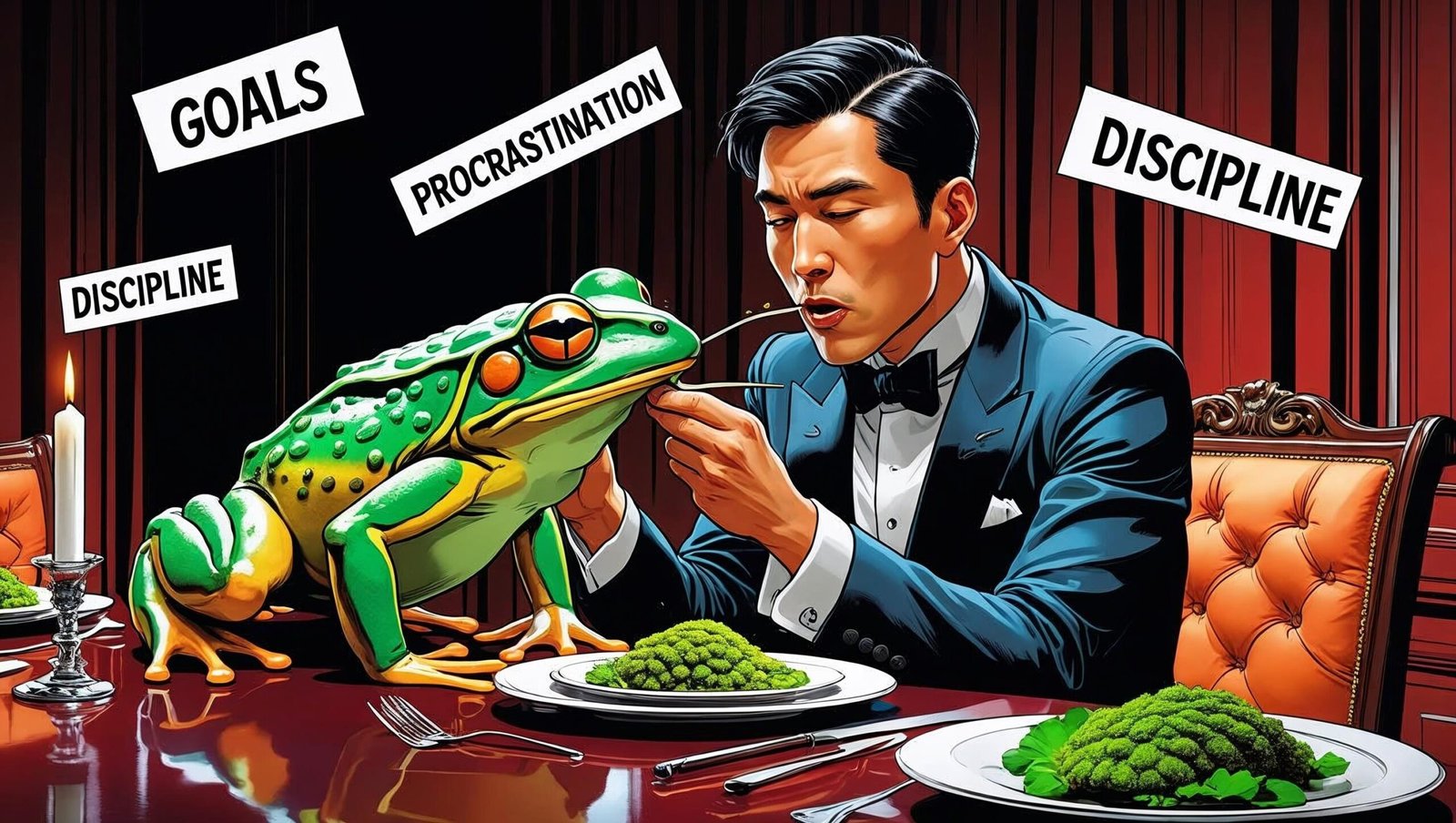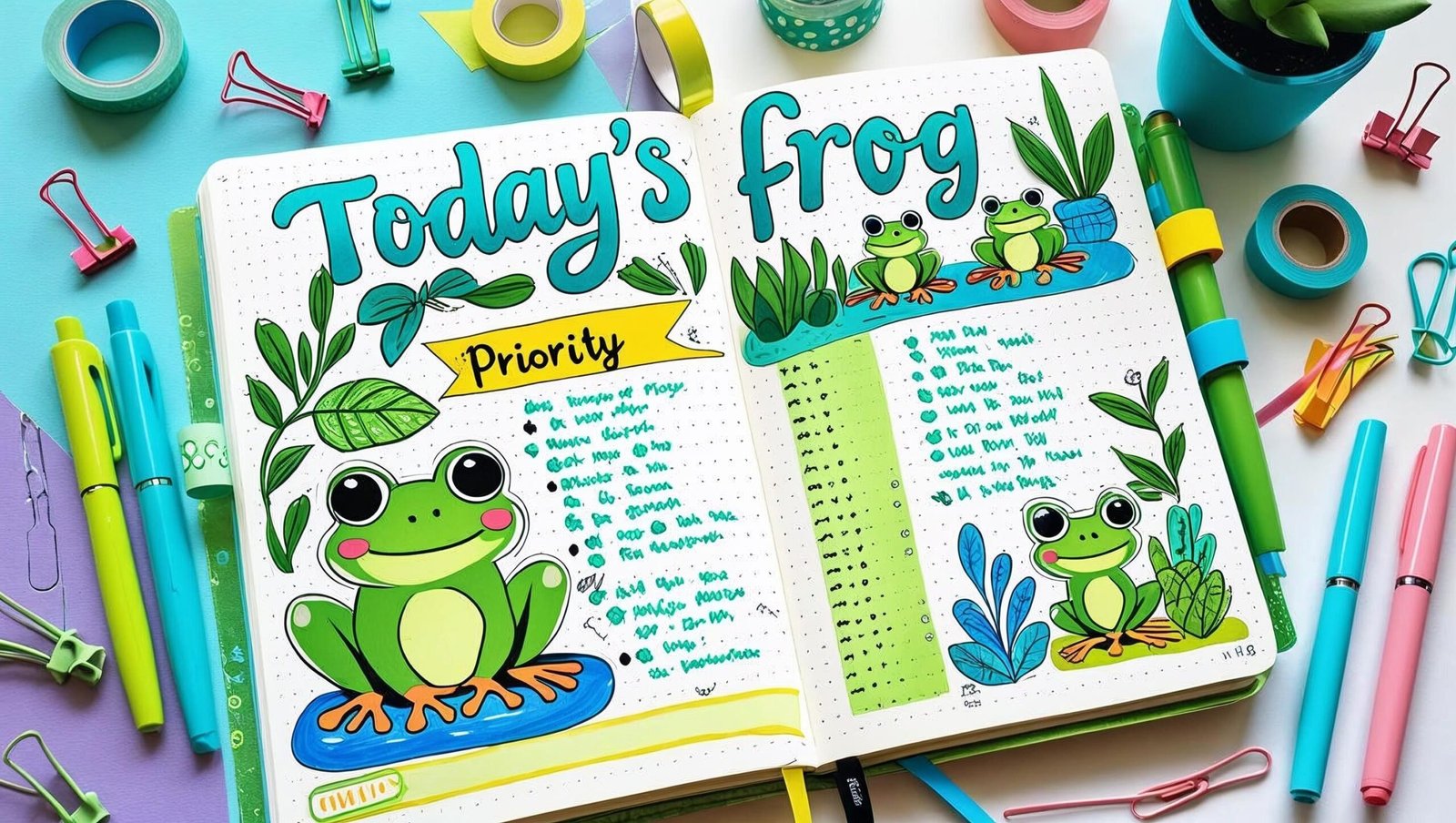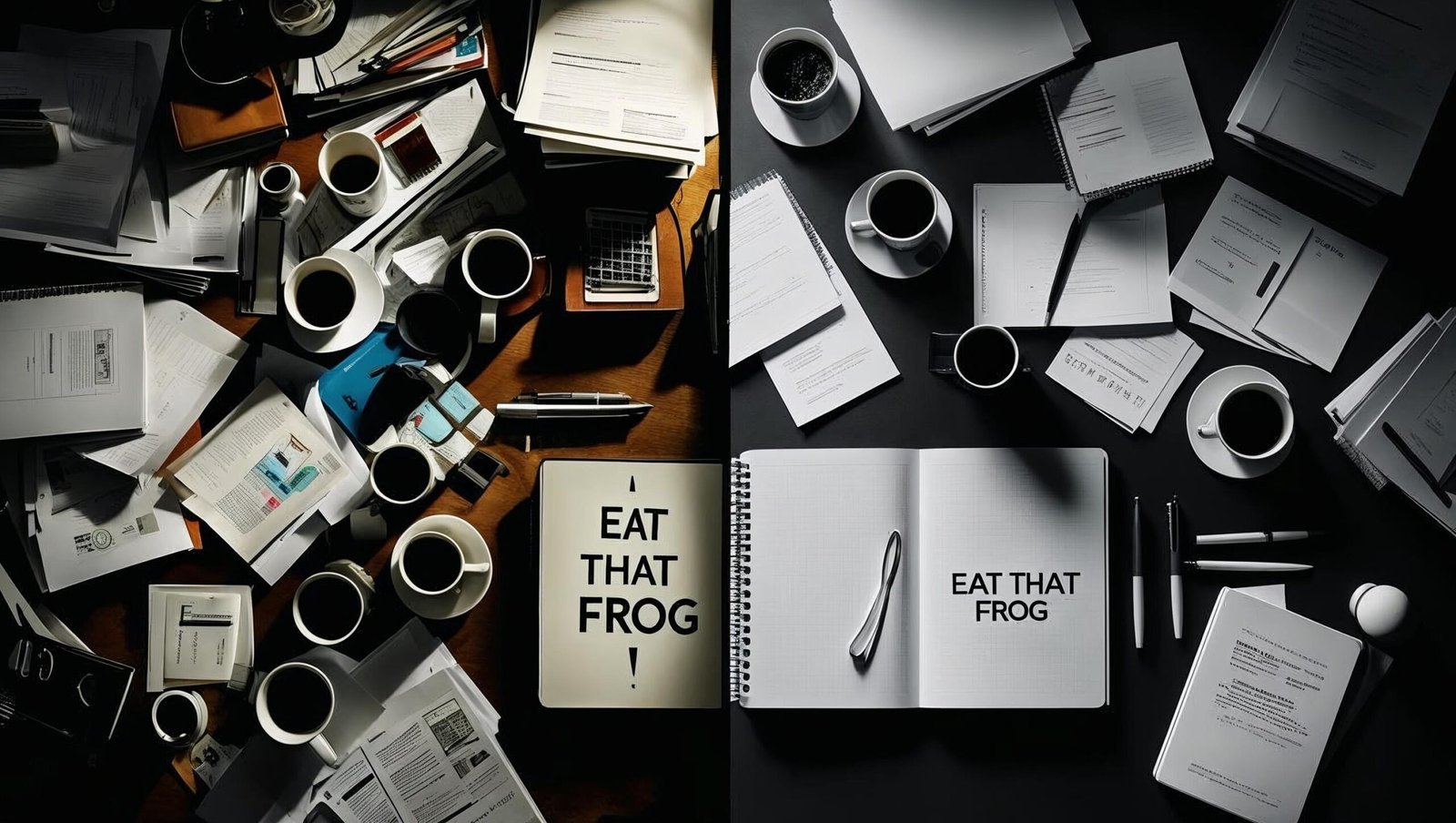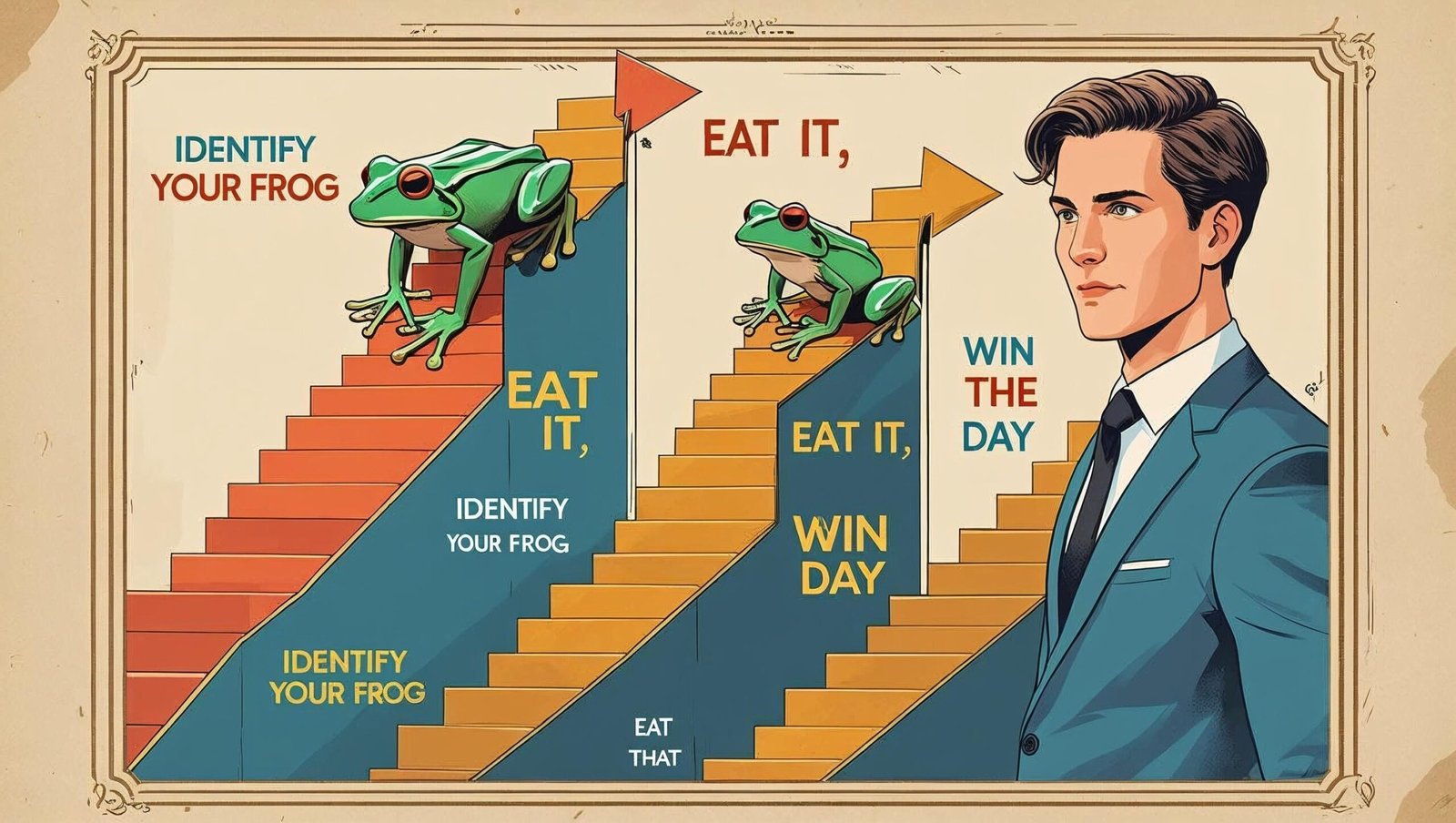Book Review: Eat That Frog by Brian Tracy
Introduction
In an age of distractions and information overload, the call for discipline, focus, and time mastery grows louder. Eat That Frog by Brian Tracy stands as a timeless manual for productivity and goal achievement. With only 21 short but potent chapters, the book distils the essence of effective time management and personal efficiency. The core idea revolves around a simple metaphor: if the first thing you do each morning is eat a live frog, you’ll have the satisfaction of knowing that it’s probably the worst thing you’ll face all day. The “frog” represents your most important task, the one you are most likely to procrastinate on.
Why This Book Matters
Eat That Frog by Brian Tracy is more than a guide—it’s a practical system. It doesn’t merely inform; it transforms. The wisdom offered within its pages is applicable to anyone—students, professionals, entrepreneurs, and homemakers. Tracy’s emphasis on planning, setting priorities, and executing without procrastination is timeless.
In a world seduced by complexity, Eat That Frog by Brian Tracy offers simplicity. In an age of excuses, it demands accountability. In a time of drifting, it urges direction.

1. Clarity is the Starting Point
The book begins with the fundamental truth: success starts with clarity. If you are not clear about your goals, then every distraction will seem like an opportunity. Tracy urges readers to define their goals in writing. According to him, clarity accounts for 80% of success. Without clarity, you are merely reacting to the world instead of acting upon it.
2. Plan Every Day in Advance
Time is perishable and irreplaceable. One of the strongest teachings in Eat That Frog by Brian Tracy is the necessity of planning each day the night before. When you write down your tasks, you engage your subconscious mind to work on them even while you sleep. It turns intention into strategy.
3. The 80/20 Rule Applies to Everything
Vilfredo Pareto’s principle finds powerful application here. Tracy explains that 20% of your activities produce 80% of your results. Identify these tasks and focus relentlessly on them. Doing so aligns your efforts with your highest returns.
4. Consider the Consequences
In Eat That Frog by Brian Tracy, the idea of long-term thinking surfaces repeatedly. One must choose tasks that offer the greatest long-term benefits. The more you think about the long-term impact of your actions, the more likely you are to choose wisely.
5. Practice Creative Procrastination
You cannot do everything. Tracy introduces the concept of creative procrastination, which means deliberately delaying tasks of low value to focus on those with high payoffs. Instead of trying to get everything done, focus on getting the right things done.
6. Use the ABCDE Method
This prioritization technique is revolutionary. Label each task:
-
A for very important,
-
B for should be done,
-
C for nice to do,
-
D for delegate, and
-
E for eliminate.
Applying this method to your task list clarifies what must be eaten first—the frog.
7. Focus on Key Result Areas
Every job or profession has a few key result areas (KRAs). Identify yours. Improve in those specific domains to magnify your overall productivity. In Eat That Frog by Brian Tracy, the message is unmistakable: excel in what matters most.

8. The Law of Three
Another powerful insight from Eat That Frog by Brian Tracy is the identification of the three core tasks that contribute the most to your success. Concentrate your time and energy on these and watch your productivity soar.
9. Prepare Thoroughly Before You Begin
Success often belongs to those who are better prepared. Tracy reminds readers to organise their workspace, resources, and mindset before undertaking major tasks. Preparation saves time and boosts confidence.
10. Take It One Oil Barrel at a Time
This metaphor borrowed from a desert survival story reminds readers to break down big projects into manageable steps. Focus on the next actionable step rather than the whole journey. Consistency beats intensity.
11. Upgrade Your Key Skills
The market rewards excellence. One central teaching of Eat That Frog by Brian Tracy is that continuous learning is non-negotiable. Identify skills that bring you the most success and devote time to mastering them.
12. Leverage Your Strengths
Rather than spending time improving your weaknesses, invest more in your strengths. Tracy argues that your biggest gains lie in doing what you’re already good at—only better.
13. Identify Your Constraints
Every system has bottlenecks. Be honest about what holds you back. It may be lack of resources, training, or personal discipline. Eat That Frog by Brian Tracy stresses the importance of eliminating or minimising these constraints.
14. Put Pressure on Yourself
Self-discipline is the cornerstone of productivity. The top performers push themselves harder than anyone else would. Tracy invites readers to take charge of their own performance standards instead of waiting for external motivation.
15. Maximise Your Personal Power
Energy and health are vital assets. Eat That Frog by Brian Tracy teaches that productivity is a function of physical well-being. Sleep, exercise, and healthy eating are not distractions—they are enablers.
16. Motivate Yourself into Action
The mind responds to self-talk. Feed yourself with positive affirmations. Replace doubt with declarations. Tracy argues that you become what you say to yourself most of the time.
17. Get Out of the Technological Time Sinks
Email, social media, and smartphones can easily destroy your focus. One of the boldest lessons in Eat That Frog by Brian Tracy is to avoid getting caught in low-value digital loops. Instead, cultivate deep work habits.

18. Slice and Dice the Task
Break large tasks into bite-sized pieces. This not only makes the job less intimidating but also allows you to start with momentum. Progress is the best motivation.
19. Create Large Chunks of Time
Deep work demands uninterrupted time. Tracy recommends blocking out time for critical tasks and protecting it fiercely. Don’t multitask. Focus breeds brilliance.
20. Develop a Sense of Urgency
Act now. Move fast. Tracy’s research shows that people with a bias for action are more productive, happier, and more successful. Eat That Frog by Brian Tracy repeatedly underscores the magic of momentum.
21. Single Handling – Finish What You Start
Starting a task and not finishing it is a form of procrastination. Tracy advocates single handling, meaning once you begin a high-value task, stay with it until it is complete. This saves time, builds confidence, and sharpens your edge.
Deep Dive into the Philosophy of Eat That Frog by Brian Tracy
While Eat That Frog by Brian Tracy presents itself as a simple productivity guide, a deeper reading reveals a coherent philosophy of time, responsibility, and human potential. It is not a book meant to be read once and shelved—it is a framework meant to be lived.
At its core, the book emphasises personal responsibility. In an era where it is increasingly common to blame external circumstances for delays and failures, Eat That Frog by Brian Tracy boldly redirects attention inward. You are the architect of your outcomes. You are the author of your schedule. You are the captain of your time. This reaffirmation of personal agency is not just empowering—it is liberating.
Another underlying principle in Eat That Frog by Brian Tracy is that discipline precedes motivation. Too often, people wait to feel motivated before they act. Tracy inverts this notion. He proposes that action leads to motivation. When you begin—even reluctantly—you gain momentum, confidence, and clarity. This insight alone can transform the work ethic of a procrastinator.
Real-World Applications of Eat That Frog by Brian Tracy
Corporate Environments
In corporate settings, employees often juggle multiple tasks, meetings, and emails. The tyranny of the urgent often overshadows the important. Adopting the frog-eating method in team structures can radically enhance productivity.
For example, if each team member begins their day by addressing their highest-priority task—before checking emails or attending meetings—the cumulative effect can lead to exponential improvements in efficiency and project completion timelines. Many productivity consultants now incorporate principles from Eat That Frog by Brian Tracy into organisational training modules.
Entrepreneurs and Startups
Startup founders are notoriously overwhelmed. With limited resources and limitless demands, prioritisation is key. Eat That Frog by Brian Tracy becomes a survival manual in such contexts. It teaches founders to distinguish between tasks that create value and those that merely fill time.
Building a Minimum Viable Product (MVP)? That’s your frog. Looking for investors? That’s your next frog. Tracy’s system helps entrepreneurs stay focused, avoid burnout, and channel their energies towards high-yield activities.

Students and Academicians
In the realm of academics, procrastination is a silent killer. Students often delay writing papers or studying for exams until the last moment. By internalising the principles of Eat That Frog by Brian Tracy, students can begin each day with their toughest academic challenge—perhaps a research assignment or complex topic—and finish it while their mental energy is highest.
Moreover, academicians managing teaching responsibilities, publishing demands, and administrative roles can greatly benefit from prioritisation and single handling, as taught in the book.
Freelancers and Creators
For creatives and freelancers, distractions are the default setting. Social media, shifting client priorities, and an unstructured workday often derail progress. Eat That Frog by Brian Tracy offers a return to structure without stifling creativity. By clearly defining what must be done first—and doing it—creatives can protect their time and produce more value.
The Psychological Underpinning of the ‘Frog’ Metaphor
The metaphor of the frog is not chosen arbitrarily. Frogs, being unpleasant and slimy, symbolize tasks we tend to avoid—be it because of complexity, effort, or fear of failure. When we delay such tasks, we experience guilt and anxiety, leading to mental exhaustion and eventual burnout.
However, when we address the frog first, we gain psychological release. We no longer carry the burden of avoidance. The rest of the day feels lighter, and subsequent tasks appear more manageable.
Eat That Frog by Brian Tracy thus becomes more than a productivity book—it becomes a therapy against procrastination-induced stress. It helps in breaking the loop of avoidance, which is often the first step to breaking the cycle of underachievement.
Critique: What Eat That Frog by Brian Tracy Misses
While the book offers timeless advice, a fair critique demands we explore its limitations.
Firstly, Eat That Frog by Brian Tracy largely operates on the assumption that the reader has control over their time. This is not always the case. For people in support roles, customer service, or healthcare, reactive work is a large portion of their day. The frog metaphor applies best to knowledge workers with control over their scheduling.
Secondly, the book is highly individualistic. It assumes that the path to productivity lies solely in personal effort and discipline. While this is true to an extent, workplace systems, managerial support, and mental health also influence productivity levels. Some readers might find the advice a bit rigid or idealistic.
Finally, the book offers limited guidance on how to sustain the habits over the long term. Reading Eat That Frog by Brian Tracy might result in an initial burst of motivation, but habit formation requires systems, accountability, and consistency—topics that are not deeply explored in this short volume.
The Relevance of Eat That Frog by Brian Tracy in a Digital Age
With the arrival of AI, endless content streams, and algorithm-driven distractions, attention has become the new currency. Focus is rare, and procrastination has become industrialised through notifications, reels, and doomscrolling.
In such a context, the relevance of Eat That Frog by Brian Tracy has actually increased. His analog, almost minimalistic approach to time management is a much-needed antidote. Instead of productivity hacks and app-based gimmicks, Tracy offers discipline-based execution. And that has stood the test of time.
Connecting with Eat That Frog by Brian Tracy on a Personal Level
The strength of Eat That Frog by Brian Tracy lies in its directness. It does not attempt to sugar-coat its message. It assumes that the reader is intelligent but distracted. And it offers a mirror—not a mask. In that sense, the book connects deeply with readers who are weary of fluff and ready for change.
Many readers report significant shifts in mindset just by implementing one or two principles from the book. For example, something as simple as writing down goals the night before and identifying the “frog” has helped readers across the globe regain a sense of purpose and daily rhythm.
Closing Thoughts: Why This Book Belongs on Every Shelf
Eat That Frog by Brian Tracy belongs on the shelf of every ambitious individual—not just for its techniques, but for its timeless principles. The book’s brevity is its strength. You can finish it in one sitting, but the impact can last a lifetime.
Its central teaching—“Start with the hardest thing first”—is not just advice. It is a philosophy, a mantra, and a discipline. It forces you to confront your inertia, fight your fear, and move toward growth. In that way, Eat That Frog by Brian Tracy is both deeply practical and spiritually motivating.

Why Consistency Matters in Applying Eat That Frog by Brian Tracy
Reading Eat That Frog by Brian Tracy once is not enough; consistent application is the key. The real transformation happens when you make “frog-eating” a daily habit. Tackling the hardest task every morning rewires your mindset toward discipline and achievement. Over time, it becomes second nature to prioritise effectively, focus deeply, and finish what matters most. The book’s power lies not just in reading it—but in living it, day by day, with unwavering commitment.
Frequently Asked Questions (FAQs)
1. What is the main message of Eat That Frog by Brian Tracy?
The book emphasizes tackling your most important and challenging task first each day—your “frog”—to build momentum and improve productivity.
2. Who should read Eat That Frog?
Anyone looking to overcome procrastination, manage time better, and boost personal effectiveness will benefit from this book.
3. How long does it take to read Eat That Frog by Brian Tracy?
The book is short and can be read in a few hours, but its ideas are meant to be applied over a lifetime.
4. Is this book still relevant today?
Absolutely. The timeless principles of Eat That Frog by Brian Tracy are more pertinent than ever in our distraction-prone digital age.
5. Can Eat That Frog help with anxiety and overwhelm?
Yes. By breaking big tasks into manageable steps and prioritising the most important ones, it reduces mental clutter and brings clarity.
Conclusion
Eat That Frog by Brian Tracy is not merely a book—it is a discipline in print. Its simplicity is deceptive; its ideas are life-changing. For those committed to doing more with their lives and time, this book is a compass.
Let this review not end as mere reading. Let it inspire daily application. As Tracy says, “The key to success is action.”
So go ahead. Eat that frog today.
For more such insights, book reviews, and practical productivity guides, visit shubhanshuinsights.com.